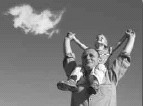From API’s Publications Team
**Originally published in the Summer 2007 Secondary Attachments issue of The Journal of API
 The term “secondary attachment” can be interpreted erroneously to mean “less important,” but Attachment Parenting International refutes this definition.
The term “secondary attachment” can be interpreted erroneously to mean “less important,” but Attachment Parenting International refutes this definition.
Primary vs. Secondary
According to the API Research Group, the term “secondary attachment” is used to describe those outside the primary figure with whom a person has formed an attachment. This differentiates them from others who are close friends but with whom there is no attachment bond.
The primary attachment bond is formed with the person most involved in rapidly responding to a baby’s cries and who initiates social play during the first seven months of his life. Regular rituals, especially those associated with nighttime parenting, also seem important when establishing the primary attachment bonds.
It is important to remember that the mother may not always be the primary attachment figure in a child’s life, though this is the case most of the time. Sir Richard Bowlby – the son of the Father of Attachment Theory, the late Dr. John Bowlby, and a member of API’s Advisory Board – said there are instances in which the nanny or childcare provider may be the primary attachment figure, with both parents being secondary attachment figures…and instances where a father may become the primary attachment figure even if the mother is more available, especially if the father is more responsive or sociable.
According to Bowlby, the primary attachment often remains the same until the child grows into an adult and has been in a long-term relationship for a period of time, at which point another adult often becomes the primary attachment figure.
Primary isn’t Better
Lauren Lindsey Porter, psychotherapist and co-director for the New Zealand-based Centre for Attachment, clarified that “primary” does not equal “better.” In research, there is solid evidence that there is one primary attachment figure, typically but not always the person who provides the majority of the care for the child. Many people believe that, via physiology such as breastfeeding, mothers are ideally set up to be the primary attachment figure and are well placed to give their children healthy attachment relationships. However, Bowlby’s work has shown that anyone can be the primary attachment figure.
Furthermore, work by Mary Ainsworth has taught us that the strength of attachment is independent of the quality of attachment. So a child could have an insecure attachment to his primary attachment figure and a secure attachment to a secondary attachment figure.
Secondary is Just as Significant as the Primary
Ann Murray, associate professor of the School of Family Studies and Human Services at the College of Human Ecology of Kansas State University, shared Ainsworth’s description of a study by Michael Lamb with Attachment Parenting International on this subject. Lamb was able to determine which caregiver was the primary attachment figure based on which parent the child went to in times of distress. The article “Patterns of Attachment: A Psychological Study of the Strange Situation” by Ainsworth, Blehar, Waters, and Wall concludes that although the child’s relationship with the primary attachment figure (referred to as “the mother”) is different from his relationship to the secondary attachment figure (referred to as “the father”), both attachments are significant determinants of social and personality development.
The Unique Role of the Father
Porter explained that while attachment research has historically looked at the mother-child relationship, more recently, researchers are actively addressing the role of fathers in developing attachment. They are finding, quite interestingly, that the early relationship with the mother is predictive of other esteem (how a child views the world, trust in others, etc.), while the early relationship with the father is predictive of self esteem (sense of self as good, lovable, etc.). These are two distinct axes of attachment security that are not about primary and secondary figures, but persist in general parental relationships. The role of the father is clearly very important, regardless of whether he is a primary or secondary attachment figure.